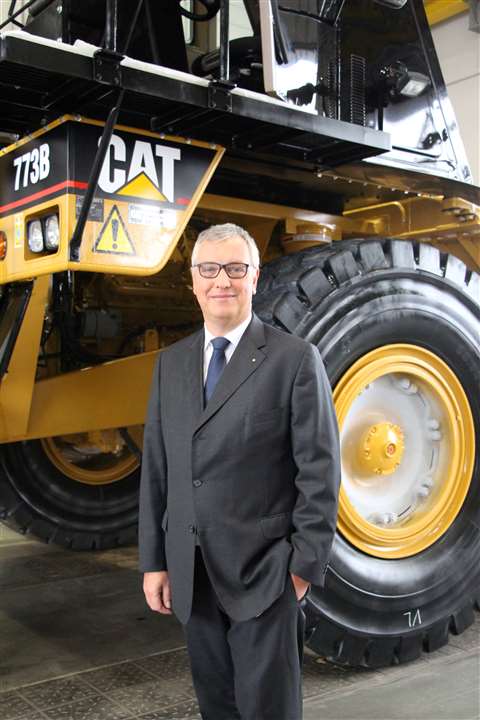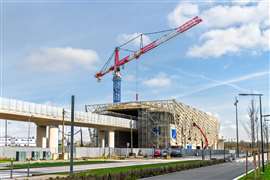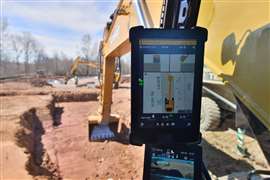COMMENT: Are we at the beginning of a golden decade in German construction?
14 September 2021
Peter Gerstmann, chairman of the board of management of the Zeppelin Group discusses growing opportunities for the German construction sector
Despite the Coronavirus pandemic, the construction industry’s order books are still full. The biggest challenges at the moment are the lack of building materials and the lack of qualified employees.
 Gerstmann highlights political fallout from German reunification as the cause of a massive infrastructure backlog.
Gerstmann highlights political fallout from German reunification as the cause of a massive infrastructure backlog.
However, according to the economic outlook of the Ifo Institute, optimism about the future in the construction industry is waning. This indicates a deterioration in economic development rather than a golden decade. Against this background, it seems risky to speak of another decade of growth. And yet I am not afraid to make this bold forecast for the future.
The reasons for such a forecast are obvious and result primarily from a - politically determined - backlog of necessary investments in the existing infrastructure and the challenges of the ecological redesign of our industrial landscape.
What’s wrong with the German infrastructure?
Germany was known for its first-class infrastructure in all industrial sectors, be it roads, motorways, railways, waterways, power lines or gas lines. After German reunification, the focus was necessarily on expansion and development in the new federal states.
The perpetual dispute over the available funds led to a neglect of the existing infrastructure in the rest of the republic. And this neglect was not just short-term, but over decades. In addition to budget shifts in the budgets, there are also “bumpy” shifts in competence for motorway construction from the federal states to the federal Autobahn GmbH, which lead to delays in the award of renovation and new construction projects.
The trunk road network is in a pitiful state - many bridges are already becoming a serious safety risk. But it doesn’t just suffer from the trunk road network. Deutsche Bahn has been crawling around building new stations and routes for years and is unable to optimize capacities and turnaround times to the seaports that are so important for export. When major airports are built in Germany, they are completed far too late, so that the demand situation has already changed due to global political developments.
The expansion of fibre optic networks, which is so important for digitalization, is making slow progress and the progress in the construction of new power lines is, if not stopped by citizens’ initiatives and courts, only at a snail’s pace.
These are just a few examples of the need to catch up and the immense investment backlog that will have to be dealt with in the next few years so that Germany remains a leading industrial location - and these are just the infrastructure measures.
What does climate change mean for the construction industry?
The last few weeks have shown us in a dramatic and tragic way that the changing environmental conditions will require a completely different type of construction work. The resilience of our cities, residential areas, industrial locations and infrastructures must be significantly improved. This will entail huge investments in the construction industry, as it will result in relocations of residential and urban areas away from the rivers and valleys. Roads and bridges, power lines and
railway connections, water and sewage systems, gas pipelines and dams have to be redesigned and built because the risk of flooding and heavy rain increases. Rising sea levels require the dikes to be raised - not only along the coast, but also along the rivers as a consequence.
All of these are just necessary responses to the changes that await us. We must provide further answers to the new challenges that arise from the necessary transformation of our industry and our way of life in order to avert further climate change.
First of all, there is the insulation of buildings, because this can undoubtedly achieve the greatest savings in CO2 emissions. Certainly, more sustainable materials with fewer plastic components will also be developed for this purpose.
When it comes to building materials, new innovations are to be expected, such as carbon fiber-reinforced concrete types, which allow completely new forms of construction and at the same time save mass.
Growing cities and their surrounding areas (“bacon belt”) have led to a blatant housing shortage. For the boom in residential and building construction, not only construction robots will be used, but 3D printing processes will change the process on construction sites. The construction processes will be accelerated as well as by digitization, which will revolutionize construction site management and the planning and material disposition processes. The acceleration in construction will make it possible to realize more and larger construction projects.
Social change demands the construction industry
The restructuring of our industrial society and the change in energy supply that has already begun to achieve our climate goals also require completely different construction measures and enormous earthworks.
The withdrawal from the generation of energy by means of nuclear power and coal will keep German demolition companies busy for years, the renaturation and dismantling of the opencast mining sites will permanently utilize the earthmoving fleets of many construction companies. In the context of the circular economy, factories for the manufacture and subsequent reprocessing (recycling) of tires, batteries, building materials, plastics, foodstuffs and similar products will increasingly be required.
We will need new industrial facilities to manufacture, store, transport and distribute energy, district heating, hydrogen, methanol and ammonia. And the increasing online trade needs logistics and distribution centres on a gigantic scale. The supply of end customers as well as the growing local public transport require the development of a comprehensive charging infrastructure for electric vehicles and hydrogen filling stations for fuel cell drives.
At the same time, the inner cities will change completely - from shopping and professional cities to residential, work and adventure cities, to almost autonomous quarters with complete supply and disposal technology, including roofs and facades equipped with solar cells.
For all these changes that have to take place in the next 25 years, the construction industry and its suppliers will be working to the limit in the next 10 years. Incredible amounts of building materials and construction machinery are required to implement it. In addition to the construction industry itself, manufacturers, suppliers and renters of construction equipment, scaffolding and mobile processing systems for building materials will also face an enormous period of growth.
STAY CONNECTED



Receive the information you need when you need it through our world-leading magazines, newsletters and daily briefings.
CONNECT WITH THE TEAM









